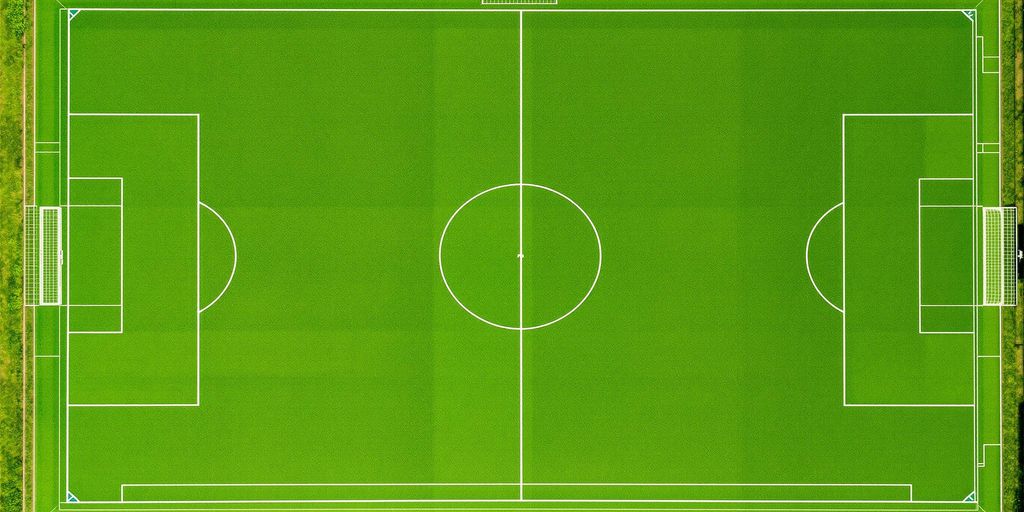Soccer Field Size Guidelines For Youth Players
Importance of Age-Appropriate Sizes
When it comes to youth soccer, one size definitely doesn’t fit all. Using the right field size for each age group is super important for player development and enjoyment. Think about it: a tiny Under 7s team trying to cover a full-sized pitch? They’d be exhausted before they even touched the ball! Age-appropriate field sizes let kids develop their skills without getting overwhelmed. It’s all about setting them up for success.
FIFA Recommendations
FIFA, the big boss of world soccer, has guidelines about field sizes for young players. They reckon that smaller fields are the way to go for youth matches. These guidelines consider the age and skill level of the players, making sure the field is just right for them. It’s not a free-for-all; there’s some thought behind it!
Benefits of Smaller Fields
Smaller fields in youth soccer? They’re a game-changer, honestly. Here’s why:
- More touches on the ball: Kids get more involved in the game.
- Improved decision-making: With less space, they have to think faster.
- Increased confidence: Success is easier to achieve on a smaller scale.
- Reduced fatigue: Less running means more energy for skill development.
Using smaller fields isn’t just about making things easier; it’s about creating an environment where young players can thrive. It allows them to develop their skills, build confidence, and most importantly, have fun. It’s an investment in the future of the sport.
Understanding Soccer Field Dimensions By Age Group
It’s pretty obvious that little tackers shouldn’t be running around on a full-sized pitch, right? The size of the soccer field needs to match the age and ability of the players. This section breaks down the recommended field sizes for different age groups, so everyone gets a fair go and can actually enjoy the game.
Under 7 & 8’s Field Size
For the Under 7 and Under 8 age groups, we’re talking about the little nippers just starting out. The field size is significantly smaller to help them develop their skills without getting completely knackered. Think of it as a mini-pitch for mini-players.
- Recommended field size: 25-35 yards (23-32 metres) in length and 15-25 yards (14-23 metres) in width.
- Smaller field = more touches on the ball.
- Usually played with 4-a-side or 5-a-side teams.
A smaller field allows these young players to experience more frequent involvement in the game, promoting skill development and a greater understanding of spatial awareness. It’s all about building a solid foundation for their future soccer careers (or at least, having a good time).
Under 9 & 10’s Field Size
As the kids get a bit older and their skills improve, the field size needs to grow with them. For Under 9 and Under 10 players, the field dimensions are increased to provide a bit more space for them to run around and develop their passing game.
- Recommended field size: 50-70 yards (46-64 metres) in length and 30-50 yards (27-46 metres) in width.
- This age group often plays 7-a-side or 9-a-side.
- The goal size also increases slightly.
Under 11 & 12’s Field Size
By the time players reach the Under 11 and Under 12 age groups, they’re starting to get a real handle on the game. The field size is increased again to prepare them for the transition to full-sized pitches in the coming years. This is where they start to learn more advanced tactics and strategies.
- Recommended field size: 70-80 yards (64-73 metres) in length and 45-55 yards (41-50 metres) in width.
- Often play 9-a-side or transition to 11-a-side on a smaller pitch.
- More emphasis on teamwork and positional play.
Soccer Field Size For Different Team Formats
5-a-side Soccer Field Dimensions
So, you’re keen on 5-a-side, eh? Good choice! It’s a fast-paced, skill-intensive version of the beautiful game. Field size is pretty important here. The dimensions aren’t set in stone, but there are some guidelines.
- Length: Around 36.5 metres (40 yards)
- Width: About 27.5 metres (30 yards)
- Markings: Should be clearly visible.
These smaller fields really encourage quick passing and close ball control. It’s all about keeping the game flowing and the players engaged. You’ll find that 5-a-side soccer games are a great way to improve your fitness too!
6-a-side Soccer Field Dimensions
Moving up a player per side, we get to 6-a-side. This format offers a bit more space to play with, but still keeps the intensity high. The field size usually sits somewhere between 5-a-side and 7-a-side, so it’s a nice middle ground.
- Length: Typically around 45-55 metres.
- Width: Usually about 30-40 metres.
- Goal Size: Slightly larger than 5-a-side goals.
The key thing to remember with 6-a-side is that it’s all about adaptability. Field sizes can vary depending on the available space, so be prepared to adjust your game accordingly. It’s a great format for developing tactical awareness and teamwork.
7-a-side Soccer Field Dimensions
7-a-side is where things start to feel a bit more like ‘proper’ soccer, especially for younger players transitioning to larger formats. The field size increases again, allowing for more strategic play and longer passes.
- Length: Around 50-60 metres.
- Width: About 35-45 metres.
- Penalty Area: Clearly marked, larger than in 5 or 6-a-side.
With 7-a-side, you’ll see more emphasis on positional play and building attacks from the back. It’s a good stepping stone to the full 11-a-side game, allowing players to develop their skills and understanding of the game in a less overwhelming environment. Selecting the right AFL ball size is also important for young players.
Regulation Sizes For 11-a-side Soccer Fields
Standard Dimensions
When we talk about 11-a-side soccer, we’re getting into the realm of what most people picture when they think of a ‘proper’ soccer match. The size of the field is pretty important here, and while there’s some wiggle room, there are guidelines to stick to. Generally, for your average 11-a-side game, the field should be between 100 and 130 yards (91.4 and 118.9 metres) long, and between 50 and 100 yards (45.7 and 91.4 metres) wide. That’s a fair bit of space to cover!
International Match Requirements
For international matches, things get a little stricter. FIFA, the big boss of world soccer, has specific rules. The length needs to be between 110 and 120 yards (100.6 and 109.7 metres), and the width between 70 and 80 yards (64 and 73.2 metres). So, while your local park might have a slightly smaller or bigger pitch, the stadiums where the Socceroos play have to meet these standards.
Field Markings and Their Importance
It’s not just about the overall size; all the lines and markings on the field are super important too. You’ve got the centre circle, the penalty areas, the goal lines – all these have specific measurements and placements. They define where players can and can’t go, where set pieces are taken, and basically, they dictate the flow of the game. Without these markings, it’d be chaos!
Think of the field markings as the rules of the road for soccer. They tell players where they can drive (or, you know, run), where they need to stop, and where the important zones are. They’re not just painted lines; they’re the framework for the whole game.
Soccer Field Size Variations For School Competitions
High School Soccer Field Dimensions
Alright, so when we’re talking about high school soccer fields, there’s a bit of wiggle room in the rules. The National Federation of State High School Associations (NFHS) reckons a field should be between 100 and 120 yards long, and 55 to 80 yards wide. That’s roughly 91.4-109.7 metres in length and 50.3-73.2 metres in width. So, not exactly a one-size-fits-all situation, which can be a bit of a headache for coaches and groundskeepers.
College Soccer Field Specifications
College fields are a bit more regulated, thankfully. The NCAA (National Collegiate Athletic Association) sets the rules here. They say a college soccer field needs to be between 115 and 120 yards long (105.2-109.7 metres) and 70 to 75 yards wide (64-68.6 metres). So, a slightly narrower range than high school, which makes things a little easier to manage.
Differences Between School and Club Fields
School and club fields can differ quite a bit, and it’s not always obvious why. Here’s a few things to keep in mind:
- Size Variations: School fields, especially at the high school level, can vary more in size due to space constraints or budget limitations. Club fields tend to adhere more closely to standard dimensions.
- Surface Quality: Club fields often have better maintained surfaces, as clubs tend to invest more in field upkeep than schools.
- Markings and Equipment: Club fields usually have clearer markings and better-quality goals and nets compared to some school fields.
It’s worth noting that these differences can impact player development. Consistent field sizes and quality surfaces allow players to adapt and improve their skills more effectively. When players are constantly adjusting to different field dimensions, it can affect their spatial awareness and overall game performance.
Famous Soccer Fields And Their Dimensions
Iconic Stadiums Around The World
Okay, so we all know soccer is a global sport, right? That means there are some seriously famous stadiums out there. Think of places like Wembley in London, the Maracanã in Rio de Janeiro, or the San Siro in Milan. These aren’t just fields; they’re historical landmarks where legends are made. Each stadium has its own unique vibe and, of course, its own specific field dimensions, even if they mostly stick to the regulations.
Comparative Sizes
It’s interesting to compare the sizes of these famous pitches. While FIFA sets guidelines, there’s still some wiggle room. For example:
- Old Trafford (Manchester United): Around 105m x 68m
- Camp Nou (Barcelona): Roughly 105m x 68m
- Wembley Stadium (London): Close to 105m x 68m
See? Pretty similar, but those few metres can make a difference in how the game is played. Some stadiums might feel wider, some longer, impacting player strategies and movement. It’s all about perspective, I guess.
Historical Changes in Field Sizes
Did you know that soccer field sizes haven’t always been the same? Back in the day, things were a lot less standardised. Early soccer fields could vary wildly in size, depending on the space available. Over time, as the sport became more organised, governing bodies like FIFA introduced regulations to ensure a more consistent playing experience. This evolution has shaped the game we know today, influencing everything from player development to tactical approaches.
It’s wild to think about how much the game has changed. From those early days with fields of all shapes and sizes to the meticulously measured pitches we see now, it’s a testament to the sport’s growth and pursuit of fairness and consistency.
Soccer Field Size Considerations For Indoor Play

Indoor Soccer Field Dimensions
Indoor soccer, or futsal, presents a different ball game compared to its outdoor cousin, and that includes the field size. Indoor soccer fields are significantly smaller than outdoor fields, and they’re usually rectangular, enclosed by walls or boards. These walls become part of the game, allowing for unique plays and strategies. The dimensions can vary depending on the league and the available space, but generally, you’re looking at a field that’s around 38–42 metres long and 18–22 metres wide. This smaller space demands quicker thinking and faster footwork.
Differences From Outdoor Fields
The most obvious difference is the size. Outdoor soccer field dimensions are much larger, allowing for more expansive play. Indoor fields also have walls, which eliminate out-of-bounds situations in many cases. Other key differences include:
- Surface: Indoor fields often use artificial turf or a hard court surface, affecting ball bounce and player movement.
- Number of Players: Indoor soccer typically involves fewer players per side, often 5 or 6, leading to a more intense, high-scoring game.
- Rules: Some rules are modified for indoor play, such as kick-ins instead of throw-ins, and different rules regarding sliding tackles.
The smaller dimensions and unique rules of indoor soccer create a faster-paced, more physically demanding game compared to outdoor soccer. Players need to adapt their skills and strategies to succeed in this environment.
Adaptations for Smaller Spaces
Playing in a smaller space requires players to adapt their skills and tactics. Here are some key adaptations:
- Close Control: Players need excellent close control and dribbling skills to navigate the confined space.
- Quick Passing: Short, quick passes are essential for maintaining possession and creating scoring opportunities.
- Shooting Accuracy: With less space to work with, accurate shooting becomes even more important.
- Physicality: Indoor soccer can be very physical, requiring players to be strong and agile.
Ultimately, the adaptations needed for indoor soccer make it a great way to improve a player’s overall game. It forces you to think faster and react quicker, which can translate well to the outdoor pitch. Plus, it’s a great way to keep playing during the off-season!
Impact of Soccer Field Size On Game Play
How Size Affects Player Performance
The size of the soccer field has a massive impact on how players perform. A larger field demands greater endurance and the ability to cover more ground, which can favour players with superior stamina and speed. Smaller fields, on the other hand, place a premium on close control, quick passing, and tactical awareness. It’s all about adapting to the space available.
Tactical Considerations
The dimensions of the pitch dictate the tactical approaches teams can employ. On a larger field, teams might opt for a more expansive game, utilising wing play and long balls to stretch the opposition. Smaller fields often lead to more congested play, requiring teams to be compact defensively and creative in tight spaces. The match timing can also influence these tactical decisions, as fatigue sets in later in the game.
Skill Development Opportunities
Different field sizes present unique opportunities for skill development. Smaller fields encourage players to develop their dribbling, close control, and short passing skills under pressure. Larger fields allow players to work on their long passing, crossing, and tackling techniques in more open spaces. It’s about creating a balanced environment where players can hone a variety of skills.
The size of the soccer field is not just a matter of dimensions; it’s a strategic element that shapes the game, influences player development, and ultimately affects the enjoyment of everyone involved.
Soccer Field Size And Player Enjoyment

Creating Engaging Environments
Let’s be honest, no one wants to play on a pitch that feels either too cramped or ridiculously vast. It’s about finding that sweet spot where players feel challenged but not overwhelmed. The right size field can really make a difference in how much players enjoy the game. Think about it: a smaller field for younger kids means more touches on the ball and more opportunities to get involved. That’s a win for keeping them engaged and excited about soccer.
Balancing Competition and Fun
It’s a tricky balance, isn’t it? You want the game to be competitive, but not at the expense of fun. Field size plays a big part here. A field that’s too big can lead to fatigue and less action, which isn’t much fun for anyone. On the other hand, a field that’s too small might feel chaotic and not allow for proper skill development. Finding the right dimensions helps strike that balance, making sure players are challenged but still having a good time. It’s about creating an environment where they can learn and grow without feeling burnt out.
Feedback From Players and Coaches
Honestly, the best way to know if a field size is working is to ask the people who are actually using it. Players and coaches have valuable insights into what works and what doesn’t. Are players getting enough touches on the ball? Are they able to implement the tactics they’ve been working on? Is the field size appropriate for their age and skill level? Getting this feedback is crucial for making sure the field size is contributing to a positive and enjoyable experience for everyone involved.
It’s easy to get caught up in regulations and standard sizes, but at the end of the day, it’s about the players. Making sure they’re having fun, developing their skills, and feeling engaged is what really matters. Sometimes, that means tweaking the field size to better suit their needs.
Here are some things to consider when gathering feedback:
- Ask players about their overall enjoyment of the game.
- Talk to coaches about whether the field size allows for effective training.
- Observe games to see how players are interacting with the space.
Wrapping It Up
So there you have it. Understanding soccer field sizes isn’t just for the pros; it matters for everyone playing the game. Whether you’re kicking a ball around in the park or competing in a serious match, knowing the right dimensions helps keep things fair and fun. From the tiny 5-a-side pitches to the full-sized fields for seniors, each size serves a purpose. It’s all about making the game enjoyable and safe for players of all ages. So next time you step onto a field, you’ll know exactly what to expect. Happy playing!




